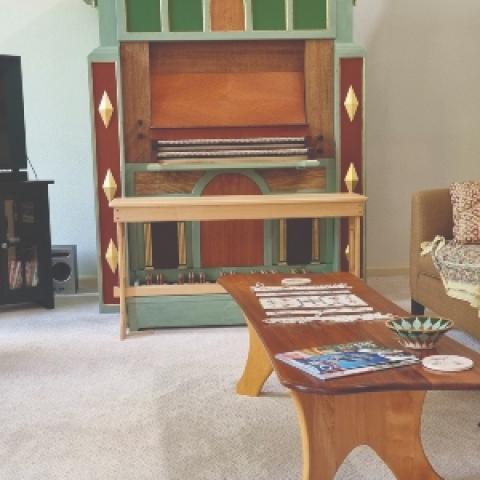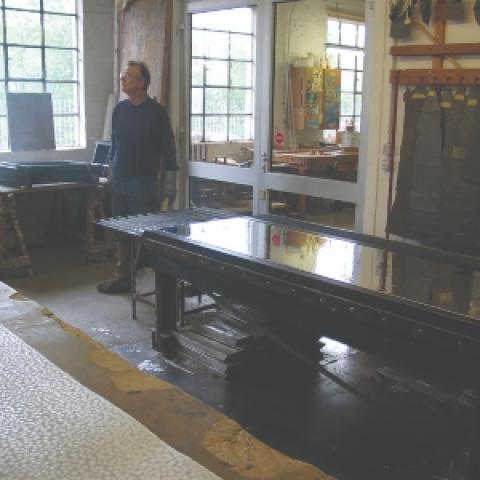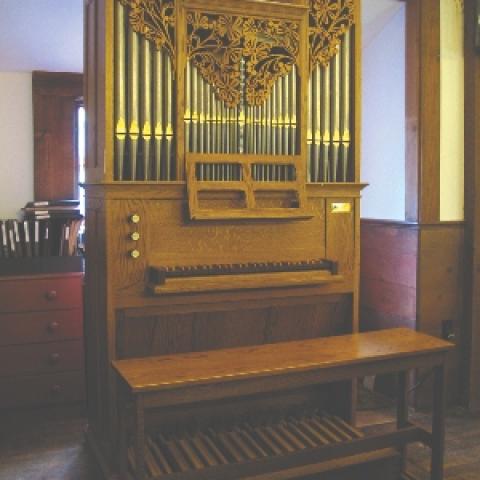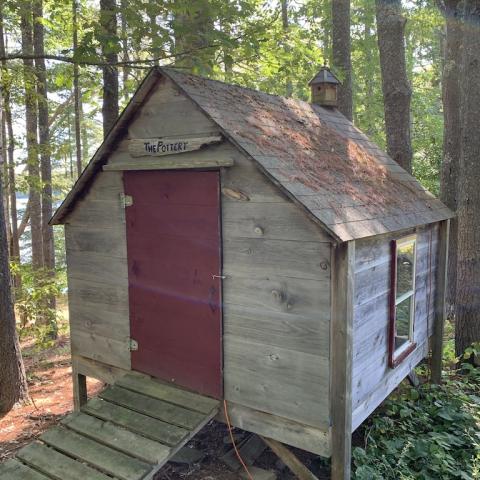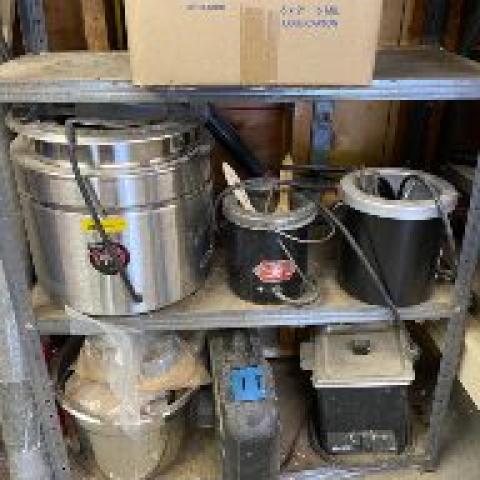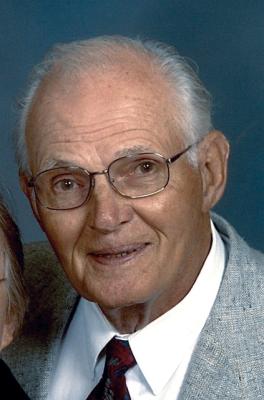
J. G. P. Leek
When I was a student at Oberlin (Class of 1978), students were not allowed to own cars, ostensibly to limit traffic and parking congestion in the small town. I lived in an apartment off campus during my senior year, and since it came with a parking space, I flouted the rule and bought a 1969 Mercedes 230. I put a great sound system in it—those cassette tapes were just the thing—and I felt like the big man driving around. It was in pretty good shape, but it was a nine-year-old Ohio car, and there were little fringes of rust here and there.
At a time when my rent was $175 per month, I splurged and spent $200 on four new Michelin tires. The next morning, I drove to the organ shop where I was working and proudly showed off the new tires. My boss, John Leek, quipped, “It’s like putting alligator shoes on a wino.”
John Leek died in Sandusky, Ohio, on November 15, 2019, just short of the age of ninety. Until a couple years ago, I called him on his birthday. We stayed in touch now and again, especially after he read about himself in this column, but I had not seen him in more than fifteen years. I dropped everything to drive to Ohio for his memorial service, but I am sorry I did not drop everything a couple years ago to visit him. I am grateful to him, I miss him, and I want to tell you about him.
His name bears the Dutch pronunciation. A bank teller commented, “Your name should be pronounced ‘leak.’” His quick quip, “Then it should be pronounced ‘Bea-thoven.’”
The wino crack was one side of John. He was able to squeeze the greatest delight from the smallest joke, and when it was a big joke, we would laugh all day. He could also be stern. He had been brought up in the rigorous system of apprenticeships in the Netherlands, starting with a cabinetmaker at a very early age and moving to organ shops in his hometown. His teachers had been tough, and so was he. He was quick with compliments and encouragement and equally quick with a hard lesson. I was late to work once. He was in the workshop, the doors were locked, and he waved me away, telling me to come back tomorrow. I was late to work only once.
§
Johannes Geratus Petrus Leek was born in 1929 in Alkmaar, the Netherlands, on the shortest day of the year, the youngest of eleven children. He apprenticed with Bernard Pels & Zonen in Alkmaar, and he continued his education in the workshops of Vermeulen, Wattell, and Verschueren. He served in the Dutch army shortly after the end of World War II. During his military service, John was seriously injured in a railroad accident. He recalled lying in the wrecked car realizing he was hurt, asking God for “twenty more years,” and then getting the creeps as the twentieth anniversary approached. I do not know the exact dates but suppose that accident happened in the early 1950s. He died last November about five weeks short of his ninetieth birthday—God granted that prayer.
After his time in the army, he returned to work in the organ shop of Verschueren. He and his wife Maria moved to the United States in 1961 as John went to work for the Holtkamp Organ Company under Walter Holtkamp, Sr. He was working on the installation of the organ in Warner Concert Hall at Oberlin when he saw a notice on a bulletin board that the school was looking for a new organ curator. “That’s the job for me.” He worked for the school from 1964 until 1976, all the while gathering organ maintenance clients “on the side,” and he left the school to start his own company in the workshop building behind his house on Route 58 (Main Street), just on the southern outskirts of town.
Just as John was starting out on his own, in the fall of my junior year, I began working with him three days a week and summers, and continued in his shop full time from my graduation until 1984, when my wife and two toddler sons moved to Boston. John was my important mentor in the craft of organbuilding. He taught me to tune, how to read and cut a piece of wood, how to glue pouches, how to build and leather a reservoir. I learned why you want wood to have standing grain for pallets in slider chests and flat grain in keyboards. (Wood warps only between the growth rings. You do not want pallets to warp so their surface does not meet the windchest grid, and you do not want keyboards to warp so the keys come into contact with each other.)
He helped me grow through the awkward end of youth when I was sure I knew everything into the awkward beginning of adulthood when I began realizing how little I knew. He never hesitated to let me know when I was full of it, and he never hesitated to confess when he was. While still an organ performance major, I was increasingly aware that organbuilding was my first love. I wondered aloud to John about quitting school so I could work with him full time. “If you quit school, you’re fired.”
Whenever my weak apprentice attempts resulted in a mangled job, John nailed it to the wall over my workbench. It turned really funny when I came back later to visit and they were still there, warning my successor apprentices to pay attention.
Road trip
Early in the summer of 1978, just after I graduated from Oberlin, we were completing construction of a harpsichord for a former student of the conservatory who lived in Oakland, California. She asked John to deliver the instrument to her, and he invited me to make the trip with him to share the driving. His offer was that I would not get paid, but he promised we would stay in the best hotels, eat the best meals, gamble in Reno, swim in the Pacific Ocean, and eat at Fisherman’s Wharf in San Francisco. John had a mustard-yellow Dodge van with a broad brown stripe (remember, those were the days of appliances in harvest gold and avocado colors), just the vehicle for such a caper, and off we went.
The trip is about 2,400 miles each way, and I suppose we drove between 400 and 500 miles each day because I remember it taking about a week in each direction. Anyone who has made a similar trip by land will appreciate our marveling at the rich agricultural heartlands, the prairies, the mountains, and the deserts. We drove all day through Iowa into Nebraska watching a huge weather system develop from the west all across the horizon, driving into light rain, and finally parking under a bridge for more than an hour waiting for the thunder, lightning, and hail to stop. We didn’t see a tornado, but that surely was on our minds.
When we stopped for gas just after entering Nevada, I put a dime in a truck-stop slot machine and won ten dollars. Bad. Very bad. We spent a night in Elko, Nevada, where we had a memorable meal in a Basque restaurant recommended by Howard Hanson, a member of Oberlin’s voice faculty. It is almost three hundred miles across flat arid land from Elko to Reno, and it seemed that we were staring at the distant mountains west of Reno all day, a visual effect that is hard to fathom the first time you see it. It was in a posh casino in Reno that I learned how it was bad that I had been sucked into the slot machine the day before. Inhibitions were loosened as the champagne was on the house, and I ran through all the quarters I could find (I think that may have been before there was such a thing as a dollar slot) while John got beaten up at a Blackjack table. It was interesting how often the dealer came up with twenty-one.
As we delivered the harpsichord, we spent two nights in the house with the customer and her physician husband, allowing us to visit San Francisco and fulfill a couple of John’s original promises. We were both smokers, and that was not allowed in the house. The second night, the good doctor brought home a preserved smoker’s lung in a jar and delivered a thoughtful lecture.
John burst randomly into song many times each day. The simple chanted Alleluia from the Roman Catholic Mass was a several-times-a-day regular. Another was a short clip from a bawdy little Dutch song asking a woman named Elena why the baby poops green. Maria and I joined elbows and sang that one for their grandchildren on the morning of the memorial service. There were many others, all brief excerpts. I do not believe John knew the complete songs, but he sure enjoyed the clips. Over and over.
John and Maria had been naturalized as citizens of the United States in 1968. He thundered the first four words of the refrain of “This is My Country” each time a new wonder was revealed on that wonderful trip. It was a punctuating anthem for a man of deep faith marveling at the process of his life that had brought him to live and work in such a huge country with such diverse landscapes.
The twinkle in his eye
John and his family were members of Sacred Heart Catholic Church in Oberlin, which was the site of his memorial service. When I worked for him, new carpet was being installed in the church, and the old had been given to a smaller church out in the countryside where the unworn sections would be enough to cover the floor. John volunteered the two of us to join a crew of parishioners removing the old carpet, which was loaded into his van and my pickup truck, where the huge roll hung over the back of my open tailgate. I was in the lead as we left on the delivery run, turning left from the church parking lot onto Lorain Street. I was stopped at the traffic light at the intersection of Main Street (Route 58) across from the art museum when I felt a strong push from behind. John had been careful to see that no traffic was coming, and, with a maniacal smile clearly visible in my mirror, was shoving me, carpet, truck, and all, through the red light into the middle of the highway.
In between organs, we built a screen porch on John’s house with a high peaked ceiling. Coming to the end of the project we were painting the floor. I was working my way out a corner with my back to John when I became aware of the quick whooshing of John’s brush flashing back and forth as he hurried to paint me into the corner.
Opus 1
In the fall of 1979, John signed a contract to build a new organ for St. Alban’s Episcopal Church in Annandale, Virginia. The organist there was Ben Dobey who had recently graduated from Oberlin as an organ major and was sure that while John had never built a pipe organ himself, he would be well able. Originally, the instrument was planned with twelve stops on two manuals, but the agreement was altered in December of 1980 to include the addition of an independent 8′ Octaafbass in the Pedal, which made necessary the construction of a separate case for the two pedal stops. You can see the specifications of the organ at https://pipeorgandatabase.org/OrganDetails.php?OrganID=8401.
The case is made of white oak with black walnut accents, drawknobs were made from a huge log of boxwood that John kept in the attic of the workshop, and the pipes were supplied by Jacques Stinkens of Zeist, the Netherlands. The slider windchests were made with sponsils, individual strips of wood fitted and glued between the ribs of the key channels to form the table surface, rather than the more usual plywood windchest table. With the experience of having built more than a dozen harpsichords, we made the keyboards in the shop. (That is when I learned about choosing slab grain.) In the first days of March 1982, I was standing at the drill press in the shop, drilling the holes in rackboards for the three windchests—start with the smallest holes so that if you make a mistake and drill an extra hole of a given size, it is easier to correct by making it bigger rather than smaller. (I have this memory exactly because those were the days of waiting for Pat to go into labor, and our first son Michael was born on March 4. I had quit smoking the previous New Year’s Eve.)
After the first week of the installation, the new organ case was standing in the church’s balcony with façade pipes in place. John and I sat proudly in the pews that Sunday as the congregation was gathering in the quiet church when a little girl near us took a look backwards and piped up clearly, “I like the old one better,” raising a polite Episcopal titter.
Patrick Summers, the current interim organist at Saint Alban’s, provided a great boost to my memory by forwarding the documents concerning the new organ from the church’s archives. As I read, John’s distinctive voice came alive. When petitioning the vestry to consider changing the schedule of payments from a list of completed components to one based on the calendar, John wrote (as Maria typed), “We would like to ask in a very polite manner from the Counsel to be paid each half year.”
John spoke English rapidly and fluently, but he never lost the grammar of his native Dutch. Coming into the shop in the morning, he would declare, “I feel myself good today,” typically followed by the ubiquitous Alleluia. (“Myself” was pronounced my-selliff, just as the name of his hometown was pronounced Allick-mar.) My primitive classroom German gives me, “Ich habe mich . . .” Although I had never been addressed by a nickname, in that workshop I was “Yonnyboy.”
Nunc dimittis
At John’s service I was reunited with his son James who runs the Leek Organ Company, his siblings Paula and Peter, their spouses and children, and his wife Maria. All of us bear the marks of the thirty-five years that have passed since my young family and I moved to Boston to start a new chapter, but the memories and stories flowed like it was yesterday. It was hilarious to hear the familiar stories as passed through the generations to John’s grandchildren, and it was fun to share some they had not heard.
John believed that there is a little voice in the head of a craftsman that pipes up when something is about to go wrong. “If you do that, you will stab yourself with that chisel.” I still hear that little voice and think of him. When I am tuning a chimney flute, I remember the moment he showed me how to hold the tool in the Congregational Church in Austinburg, Ohio, and I remember his teasing my beginner’s “yo-yo tuning” in the chapel at the College of Wooster. He insisted that I learn to tune with both hands and made me tune entire organs left-handed. There are some pipes you just cannot reach with your right hand.
John Leek was not a nationally known organbuilder, but he was widely known by generations of students at Oberlin that gave him an impressive reach. Many of my friends worked for him during their student years, and many other former students have commented in recent weeks about how generous he was with advice and goodwill. He built more than a dozen harpsichords and two pipe organs, renovated or restored dozens more, and performed thousands of service calls on hundreds of different organs. While I worked with him, we helped install four new Flentrop organs including the big three-manual instrument at Trinity Cathedral in Cleveland. I believe his greatest legacy was as a teacher, sharing his old-world experience, knowledge, and insight with young craftsmen.
John and I worked regularly on the big Aeolian-Skinner organ at the Church of the Covenant in Cleveland, releathering a division at a time and doing regular tuning visits. As we left the church one afternoon, a woman was contemplating a flat tire, and we offered to change it for her. When we finished, she thanked us profusely, declaring that there would be a special place in heaven for us. John replied, “Yes, tuning harps.”

